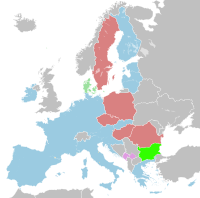
Photo from wikipedia
Background In inflammatory joint diseases, joint swelling is regarded as a sign of inflammation, which is associated with structural progression [1-3]. However, the significance of tenderness without swelling is unclear.… Click to show full abstract
Background In inflammatory joint diseases, joint swelling is regarded as a sign of inflammation, which is associated with structural progression [1-3]. However, the significance of tenderness without swelling is unclear. Objectives To determine whether clinical tenderness can be considered a sign of inflammatory joint activity in patients with rheumatoid arthritis (RA), osteoarthritis (OA), or psoriatic arthritis (PsA) Methods 36/24/30 patients respectively with RA, OA and PsA were included in the study. Each patient underwent clinical examination, followed by an ultrasound examination of bilateral MCP 1-5 (metacarpophalangeal), PIP 1-5 (proximal interphalangeal) joint and wrists; the sonographer was blinded to clinical data. On clinical examination synovial swelling and tenderness were evaluated using a binary scoring method, and tender, non-swollen joints (TNS) were identified. Grey-scale signs of synovitis (GS) and Power Doppler signal (PD) were evaluated using a semiquantitative grading system. Differences of PD signals between groups (RA vs. OA, RA vs. PsA, TNS vs. non-tender non-swollen joints) were calculated by Chi-Square test. Furthermore, joints of RA and PsA patients were tracked back for up to 6 years to identify the time point of the last swelling of that respective joint. Kaplan-Meier estimates for the occurrence of the last time point of swelling were compared between PD positive and PD negative TNS joints. Results TNS joints more often showed PD signal in RA patients as compared to those with OA and PsA (18.7% vs. 11.5% vs. 9.2%, respectively, p=0.135 for RA vs. OA; p<0.01 for RA vs. PSA). TNS joints were significantly more often PD positive as compared to non-tender non-swollen joints (18.7% vs. 10.3% respectively, p<0.01) in RA, but not in PsA (9.2% vs. 7.6%, p=0.54) or OA (11.5% vs. 10.2%, p=0.72) (fig. 1). Kaplan-Meier analysis revealed a significantly shorter time period to last observed swelling in PD positive as opposed to PD negative TNS joints in both RA (45.2 vs. 65.5 months, p=0.017) and PsA (20.6 months vs. 107.7 months, p<0.001), however we found no difference in GS positive vs. negative TNS joints. Conclusion The results of this study confirm the current practice of considering tenderness a sign of active inflammation in RA, but imply that this may not be the case in PsA or OA. The fact that shorter time to last swelling was associated with positive PD in TNS joints suggests that, at least in RA, tenderness might reside after prior clinical swelling has resolved. References [1] Conaghan PG, et al., Arthritis Rheum2003; 48: 64-71. [2] Aletaha D, et al. Ann Rheum Dis2011; 70: 1975-1980. [3] Aletaha D, et al. Arthritis Rheum2011; 63: 3702-3711.Abstract THU0133 – Figure 1 Power Doppler signals of tender non-swollen joints compared to non-tender non-swollen joints in rheumatoid arthritis (RA), psoriatic arthritis (PsA) and osteoarthrosis (OA). Disclosure of Interests Irina Gessl Grant/research support from: Travel Grant, Mihaela Popescu: None declared, Victoria Schimpl: None declared, Gabriela Supp: None declared, Michael Zauner: None declared, Michaela Loiskandl: None declared, Martina Durechova: None declared, Josef S. Smolen Grant/research support from: AbbVie, Eli Lilly, Janssen, MSD, Pfizer, Roche, Consultant for: AbbVie, Amgen, Astra-Zeneca, Astro, Celgene Corporation, Celtrion, Eli Lilly, Glaxo, ILTOO, Janssen, MedImmune, MSD, Novartis, Pfizer, Roche, Samsun, Sanofi, UDB, Speakers bureau: AbbVie, Amgen, Astra-Zeneca, Astro, Celgene Corporation, Celtrion, Eli Lilly, Glaxo, ILTOO, Janssen, MedImmune, MSD, Novartis, Pfizer, Roche, Samsun, Sanofi, UDB, Daniel Aletaha Grant/research support from: AbbVie, Bristol-Myers Squibb, and MSD, Consultant for: AbbVie, Bristol-Myers Squibb, Eli Lilly, Janssen, Medac, Merck, MSD, Pfizer Inc, Roche, and UCB, Speakers bureau: AbbVie, Bristol-Myers Squibb, Eli Lilly, Janssen, Medac, Merck, MSD, Pfizer Inc, Roche, and UCB, Peter Mandl: None declared
Journal Title: Annals of the Rheumatic Diseases
Year Published: 2019
Link to full text (if available)
Share on Social Media: Sign Up to like & get
recommendations!